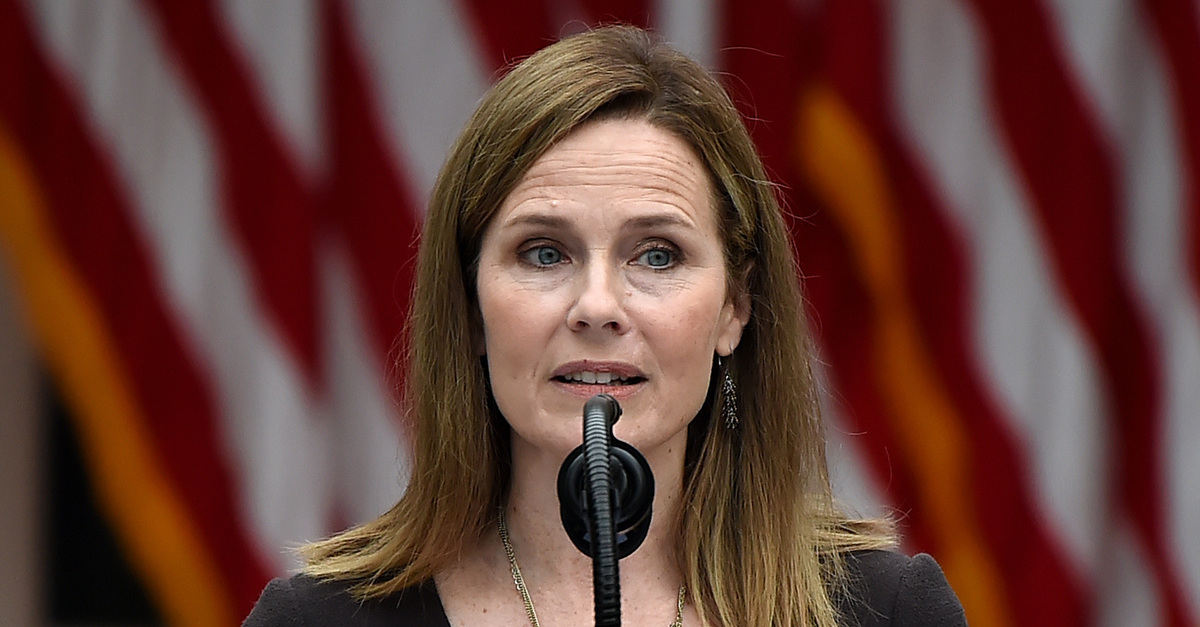
The careening course of the novel coronavirus (COVID-19) outbreak at the White House is threatening to tear a multiple-senator-sized hole right through Senate Majority Leader Mitch McConnell‘s (R-Ky.) best laid plans for the Supreme Court.
On Saturday morning, Sen. Ron Johnson (R-Wisc.) joined the ranks of GOP senators to test positive for the often deadly contagion–and will “isolate until cleared by his doctor,” according to the Associated Press. The Wisconsin Republican’s absence comes at a crucial time and is the latest loss for a quickly-dwindling GOP majority.
Fellow Senators Mike Lee (R-Utah) and Thom Tillis (R-N.C.) confirmed that they both tested positive for COVID-19 on Friday and would each quarantine for at least 10 days–bringing the number of active Senate Republican Conference members to 50 and casting some doubts as to whether or not confirmation hearings for Supreme Court nominee Amy Coney Barrett will move forward as planned.
The Senate Judiciary Committee is currently projecting an image of strength and poise regarding the situation. Committee Chairman Sen. Lindsey Graham (R-S.C.) recently told CNN that he plans to begin Barrett’s hearing on October 12 with an eye towards a final confirmation vote on October 22–but Senate rules and potential Democratic Party stalling tactics threaten to upend that schedule in light of the Rose Garden superspreader event that has taken the three GOP senators out of action for the time being.
The process of advancing a Supreme Court nominee is multi-tiered. After formal nomination by president and acceptance by the would-be high court judge, the Senate Judiciary Committee collects evidence, records and holds brief hearings that are then reported out with a determination that any given nomination should be confirmed, rejected, or, rarely, with no recommendation at all. This process typically lasts about a month and is seen as a time period for both sides to prepare for the broader confirmation battle. McConnell and Graham are acting on an ultra-expedited schedule in Barrett’s case.
After that, the full Senate holds hearings and votes–a simple majority is required for the confirmation of all U.S. judges. But right now, due to those three COVID-19 positive GOP senators taking themselves temporarily out of contention, the votes to move Barrett’s nomination forward are lacking in both the committee and the upper chamber generally.
According to the Rules of Procedure of the U.S. Senate Committee on the Judiciary, the GOP likely does not have a quorum that can move Barrett’s nomination onto the floor of the Senate because two out of the three COVID-19 subtractions–Senators Lee and Tillis–are members of the Senate Judiciary Committee.
Per those rules [emphasis added]:
Seven Members of the Committee, actually present, shall constitute a quorum for the purpose of discussing business. Nine Members of the Committee, including at least two Members of the minority, shall constitute a quorum for the purpose of transacting business. No bill, matter, or nomination shall be ordered reported from the Committee, however, unless a majority of the Committee is actually present at the time such action is taken and a majority of those present support the action taken.
While the Senate has conducted remote committee hearings due to the ongoing pandemic as of late, the Judiciary Committee rules state that members must be “actually present” and in “support” to advance a nomination. Were Democrats to actually play hard ball with Barrett’s nomination using procedural methods, a Democratic senator could make a “quorum call” or other parliamentary inquiry to delay the process and potentially win on the merits. Also, notably, McConnell has expressly rejected remote and proxy voting in the past–and there are currently no Senate rules in effect that allow for remote voting on the floor.
The Senate Judiciary Committee has 22 members–12 Republicans and 10 Democrats–which means a majority for quorum purposes is 12 members. So, if Democrats decline to attend Barrett’s hearings–as many Democrats have said they might or will do–then the smaller body simply can’t move forward with the controversial nomination, at least until both Lee and Tillis (potentially) return.
And, according to CNN’s Manu Raju, the GOP is worried about precisely the prospect of a Democratic Party “boycott.”
Full Senate quorum rules are also implicated here: the Constitution requires 51 senators to be present before the Senate is actually in session. With the active GOP majority currently at 50 votes, the Democrats could, in theory, boycott a would-be floor session on Barrett’s nomination as well and grind the body to a halt–insofar as things currently stand with the known and reported COVID-19 diagnoses. Notably, Sen. Chuck Grassley (R-Iowa) was also in attendance at the event that likely led to his colleagues’ and the 45th president’s infection. But he has said he will not seek testing.
But there’s at least one more wrinkle here.
As of now, due to Johnson’s isolation and COVID-19 positive status in tandem with the two Judiciary Committee losses, the GOP also does not have the votes for Barrett on the full Senate floor.
Currently, two GOP senators have expressed their opposition to confirm any Supreme Court nominee before the November general election: Sen. Susan Collins (R-Maine) and Sen. Lisa Murkowsi (R-Alaska). Each have said they believe the winner of the election should replace the late Justice Ruth Bader Ginsburg.
With potential “no” votes from both Collins and Murkowski, and the GOP down three members, Barrett would currently lose 49-48.
The calculus and numbers would instantly change, of course, in the event that Johnson, Tillis or Lee leave quarantine.
Per The American Prospect‘s David Dayen:
As of right this moment, with 3 Senators testing positive and quarantined and Collins/Murkowski opposed, ACB does not have the votes to be confirmed (if Collins/Murk vote no). If and when Johnson/Tillis/Lee leave quarantine, that changes. But right now, the Nos have it. https://t.co/QhUZYFx4Th
— David Dayen (@ddayen) October 3, 2020
[image via OLIVIER DOULIERY/AFP via Getty Images]